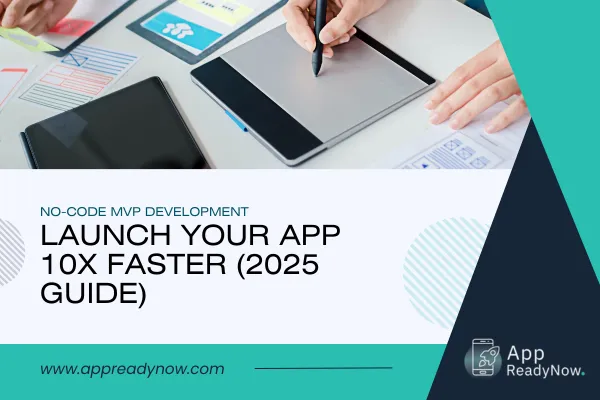
No-Code MVP Development: Launch Your App 10x Faster (2025 Guide)
In today's hyper-competitive startup world, getting your product to market quickly is a critical advantage. Enter no-code MVP development—an approach that allows founders to build, test, and launch applications without writing a single line of code. In 2025, this strategy is helping startups create powerful, scalable applications in record time. Let's dive into how you can leverage no-code MVP development to bring your vision to life.
What is No-Code MVP Development?
No-code MVP development refers to creating a Minimum Viable Product (MVP) using platforms that require no traditional programming skills. These platforms offer visual development tools, templates, and integrations, allowing founders to focus on solving user problems rather than getting bogged down with technical complexities.
In 2025, leading no-code platforms like Bubble, Adalo, Glide, and Webflow provide rich functionalities, supporting businesses from ideation to scaling.
5 Benefits of No-Code for Startups
1. Rapid Development
With no-code tools, entrepreneurs can build and launch MVPs within weeks, slashing traditional timelines by over 70%.
2. Cost-Effective
No-code development significantly reduces the need for large development teams, helping startups save thousands of dollars in early-stage expenses.
3. Accessibility for Non-Technical Founders
You no longer need a Computer Science degree to build a tech startup. No-code empowers founders to bring their ideas to life without needing technical co-founders or expensive developers.
4. Flexibility and Iteration
Rapid iteration is at the heart of successful startups. No-code platforms make it easy to adjust features based on user feedback without weeks of redevelopment.
5. Lower Risk
By validating ideas early with minimal investment, no-code MVPs reduce the financial risk of launching a new venture.
Step-by-Step Process to Build an MVP with No-Code Tools
Step 1: Ideation and Market Research

Start by identifying a real problem and a target audience. Research the market to validate your assumptions through surveys, interviews, focus groups, and by studying competitors. Ensure that there's a genuine demand for your solution before investing time and resources.
Step 2: Define Core Features and User Flow
Create a list of core functionalities essential to solving your target users' main problem. Map out the user journey—what steps users need to take from sign-up to achieving their goal. Focus only on 'must-have' features for the MVP.
Step 3: Platform Selection
Choose the most suitable no-code platform based on:
Complexity of the app.
Whether it's a mobile or web app.
Scalability needs.
Popular choices:
Bubble: Highly customizable and ideal for complex web apps.
Adalo: Best for creating mobile applications.
Webflow: Perfect for marketing sites or simple platforms.
Glide: Great for simple data-driven apps using Google Sheets.

We recommend:
We use Bubble No-code app platform from years, and we highly recommend you to use it. Main reason being is it's an all-in-one tool from database management to workflow automation to securing your app by setting strict privacy rules all within their platform is available.
Step 4: Wireframing and Prototyping

Sketch the layout of your app using tools like Figma. Focus on user experience (UX) and intuitive navigation.
Develop clickable prototypes to visualize workflows before actual building.
Step 5: Visual Design and Development
Start designing the real app using drag-and-drop editors. Pay attention to:
Responsive design (desktop and mobile optimization).
Branding consistency (colors, fonts, logo).
Simplicity: Avoid clutter to ensure ease of use.
Build one feature at a time and continuously test as you develop.
Step 6: Integrations and Automation
Integrate essential tools for:
Payments (Stripe, PayPal).
Notifications (Twilio, OneSignal).
Databases (Airtable, Xano).
Analytics (Google Analytics, Mixpanel).
Use automation platforms like Zapier or Make(formerly Integromat) to connect different services without coding.
Step 7: User Testing and Validation
Test your MVP with a small group of target users. Collect feedback through surveys, interviews, or behavior analytics tools like Hotjar.
Iterate based on real user feedback. Prioritize fixing issues that impact user experience and core functionalities.
Step 8: Launch and Iterate
Officially launch your MVP to the broader audience.
Use landing pages to drive signups.
Leverage social media and email campaigns for user acquisition.
Monitor usage analytics, conversion rates, and user behavior.
Quickly iterate based on new feedback and data insights to refine your app post-launch.
Case Study: How Odyseek Launched in 6 Weeks and Saved Over $500k

Odyseek, a travel experience platform, needed a quick, cost-effective launch. Instead of hiring a traditional dev team, they turned to Bubble's no-code platform.
Reference: https://bubble.io/showcase/odyseek
The result?
Completed their MVP in just six weeks.
Saved over $500,000 in development costs.
Rapidly tested and refined their offering based on early user feedback.
Today, Odyseek stands as a shining example of how powerful no-code MVP development can be for ambitious startups.
Addressing Scalability Myths
A common misconception is that apps built with no-code tools cannot scale. Here's why that myth is outdated in 2025:
Integration Capabilities: No-code apps easily integrate with APIs, databases, and cloud services.
Custom Code Options: Many platforms allow adding custom code for unique needs.
Proven Examples: Several successful startups have scaled their operations into multi-million dollar ventures using no-code foundations.
Scalability is about smart architecture and planning—not just the tools you use.
When to Choose No-Code vs Custom Development
Deciding between no-code and custom development isn’t about "right or wrong," it’s about finding what empowers your idea best.
Choose No-Code When:
You’re eager to move fast and see if the market truly wants what you’re building.
Your resources are limited and you’d rather spend smart than spend big.
Your app’s needs are straightforward—think user accounts, profiles, bookings, simple transactions.
You need agility. Tweaking, pivoting, and iterating without developers holding the reins.
If your goal is to prove a concept, win early adopters, or get feedback before pouring major investments into tech, no-code is your launchpad. And honestly, it's exciting to watch your idea go live without endless tech meetings and coding marathons!
Choose Custom Development When:
Your app dreams are bigger, bolder, and demand unique functionalities no existing no-code tool can support.
You don’t have time and budget constraint.
You’re scaling at a pace where milliseconds of loading time matter and custom performance tuning is a must.
You want complete freedom—owning your codebase, building deeply integrated systems, and future-proofing for years ahead.
Custom development is like building your dream house from scratch—you get full control but it takes more time, expertise, and money. It’s the right move when you’ve validated your idea and are ready to create something enduring and distinct.
Bottom line: It’s not "no-code vs code". It’s "what stage am I in" and "what's the smartest way to move forward." You’re the captain of this ship, and both paths are powerful—you just need to pick the right one for the journey you’re on.
Book a Free Consultation to Validate Your Idea
Are you ready to transform your startup dream into reality—faster and more affordably?
Book a free consultation today!
Our no-code MVP development experts will help you validate your idea, choose the right platform, and map out a launch strategy tailored to your goals.
Don't wait — your app could be live in just a few weeks!


